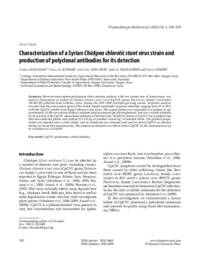Characterization of a Syrian Chickpea chlorotic stunt virus strain and production of polyclonal antibodies for its detection

Authors:
Reverse transcription-polymerase chain reaction analysis with two primer sets of luteoviruses was used to characterize an isolate of Chickpea chlorotic stunt virus (CpCSv, genus Polerovirus, family Luteoviridae) (SC402-08) collected from Lattakia, Syria, during the 2007‒2008 chickpea growing season. Sequence analysis revealed that the coat protein gene of the isolate shared nucleotide sequence identities ranging from 97 to 98% with the CpCSv isolates from Egypt, morocco and Syria. The capsid protein was separated as a protein of approximately 20 kDa in sodium dodecyl sulphate polyacrylamide gel electrophoresis, and was visually detected by its reaction with CpCSV monoclonal antibody in Western blot. SC402-08 isolate of CpCSV was purified from faba bean-infected plants, and yielded 112–182 μg of purified virions kg-1 of infected tissue. The purified preparation was injected into a white rabbit, and an antiserum was obtained and used to detect CpCSv in infected tissues by tissue-blot immunoassay. The antiserum obtained was able to detect CpCSv by the immunoassay up to a dilution of 1:1,024,000. Keywords: CpCSV; purification; rabbit antibody
